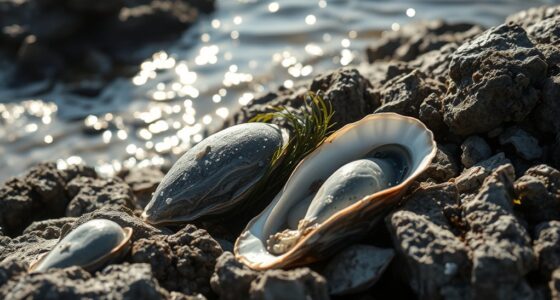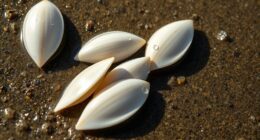Responsible sea urchin (uni) harvesting prioritizes safety and environmental stewardship by following strict regulations, using proper gear, and focusing on mature urchins to avoid overharvesting. You should be aware of size limits, seasonal restrictions, and quotas to help protect populations. Monitoring programs are essential, as they guide sustainable practices and ensure ecosystem health. Continuing to explore this topic will reveal how these practices protect both harvesters and our ocean’s delicate balance.
Key Takeaways
- Follow local regulations on size limits, seasonal closures, and quotas to ensure sustainable harvesting practices.
- Use careful, non-destructive tools like hand rakes or tongs to minimize environmental impact.
- Participate in monitoring programs to help track population health and inform responsible harvesting.
- Target mature urchins, avoiding juveniles to support ongoing reproduction and ecosystem stability.
- Respect marine ecosystems by avoiding seabed disturbance and practicing selective, eco-friendly collection methods.

Have you ever wondered how sea urchins are harvested from the ocean? It’s a process that requires careful planning and respect for marine ecosystems. Harvesting sea urchins isn’t just about gathering a delicacy; it involves sustainable practices to guarantee these creatures remain abundant for future generations. When you participate in or observe sea urchin harvesting, you should be aware of harvesting regulations that guide how many urchins can be collected and when. These regulations are in place to prevent overharvesting, which can damage the ecosystem and threaten the species’ survival. By following these rules, you help maintain a healthy balance in the ocean’s delicate environment.
Harvesting sea urchins responsibly ensures marine ecosystems remain healthy and sustainable for future generations.
Using sustainable practices means more than just adhering to regulations. It involves choosing methods that minimize environmental impact. For instance, some harvesters use selective collection techniques that target mature urchins, leaving younger ones to grow and reproduce. This approach assures the population remains stable over time. Additionally, many harvesters avoid disturbing the seabed or damaging other marine life while collecting urchins. They often use specific tools, such as hand rakes or tongs, to carefully extract the creatures without causing unnecessary harm to their habitat. This mindful approach helps preserve the ocean floor and the complex ecosystems that depend on it.
When you’re involved in sea urchin harvesting, complying with local harvesting regulations is essential. These regulations typically specify the size of urchins that can be collected, as well as seasonal restrictions to protect spawning periods. By respecting these rules, you contribute to a sustainable industry that supports local economies without depleting natural resources. It’s also common for regulatory bodies to establish quotas, which limit the total number of urchins harvested in a given period. These limits are based on scientific assessments of population health, and adhering to them assures that harvesting remains sustainable over the long term.
In addition to following regulations, responsible harvesters often participate in monitoring programs that track urchin populations and health. This data helps refine harvesting practices and update regulations as needed to adapt to changing environmental conditions. Educating yourself about these practices and regulations demonstrates your commitment to stewardship and the preservation of marine biodiversity. When you harvest sea urchins with care, respecting both sustainable practices and harvesting regulations, you help protect this valuable resource. By doing so, you guarantee that future generations can continue to enjoy and benefit from the unique flavors and ecological importance of sea urchins in our oceans.
Frequently Asked Questions
What Are the Health Benefits of Consuming Sea Urchin?
Eating sea urchin offers impressive nutritional advantages, including high-quality protein, vitamins, and minerals that support your overall health. You’ll also benefit from omega-3 fatty acids, which promote heart health and reduce inflammation. These omega-3 benefits can improve your brain function and boost your immune system. By enjoying sea urchin, you’re fueling your body with essential nutrients that help you stay energized and healthy.
How Do Regulations Vary Between Different Harvesting Regions?
Across regions, regulations shape your harvesting experience like a dance, guiding your steps with regional licensing and harvesting quotas. In some areas, strict rules protect the delicate ecosystem, limiting your catch and requiring permits that ensure sustainable practices. Elsewhere, looser regulations invite more freedom but demand your awareness of local laws. You must stay informed, respecting these boundaries to enjoy responsible harvesting and safeguard the sea’s vibrant balance.
What Equipment Is Essential for Safe Sea Urchin Harvesting?
You need essential equipment like protective gear and harvesting tools for safe sea urchin harvesting. Wear gloves to protect your hands from spikes, and use a sturdy rake or tongs to carefully collect the urchins. Safety goggles can shield your eyes from accidental punctures. Make sure your tools are sharp and reliable to avoid slips, and always handle sea urchins with care to prevent injuries.
How Can Consumers Identify Sustainably Harvested Uni?
To identify sustainably harvested uni, look for eco-friendly certification labels like MSC or ASC, which indicate responsible harvesting practices. You can also ask about the harvesting impact on local ecosystems, ensuring minimal environmental disruption. By choosing uni with these certifications and information, you support sustainable practices that protect sea urchin populations and their habitats, ensuring a healthy future for this delicacy and the oceans it comes from.
Are There Any Common Misconceptions About Sea Urchin Harvesting?
Many believe sea urchin harvesting harms ocean ecosystems, but myth busting shows sustainable practices protect marine health. A common misconception is that all uni comes from overfished areas; however, responsible harvesting supports local economies and conservation. You might think harvesting is reckless, but careful regulations and research guide the process. By understanding harvesting myths, you can appreciate how responsible practices guarantee uni remains a delicious, sustainable delicacy.
Conclusion
As you harvest sea urchins, remember you’re tending a delicate balance, like walking a tightrope over an ocean of life. Prioritize safety and stewardship, treating these creatures with respect and care. Your responsible actions ensure the ocean’s health and the future of this treasured delicacy. By working thoughtfully, you become a guardian of the sea’s treasures, preserving its beauty for generations to come. Let your harvest be a symphony of sustainability and respect.










